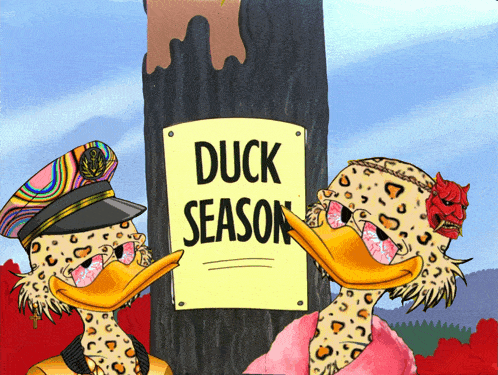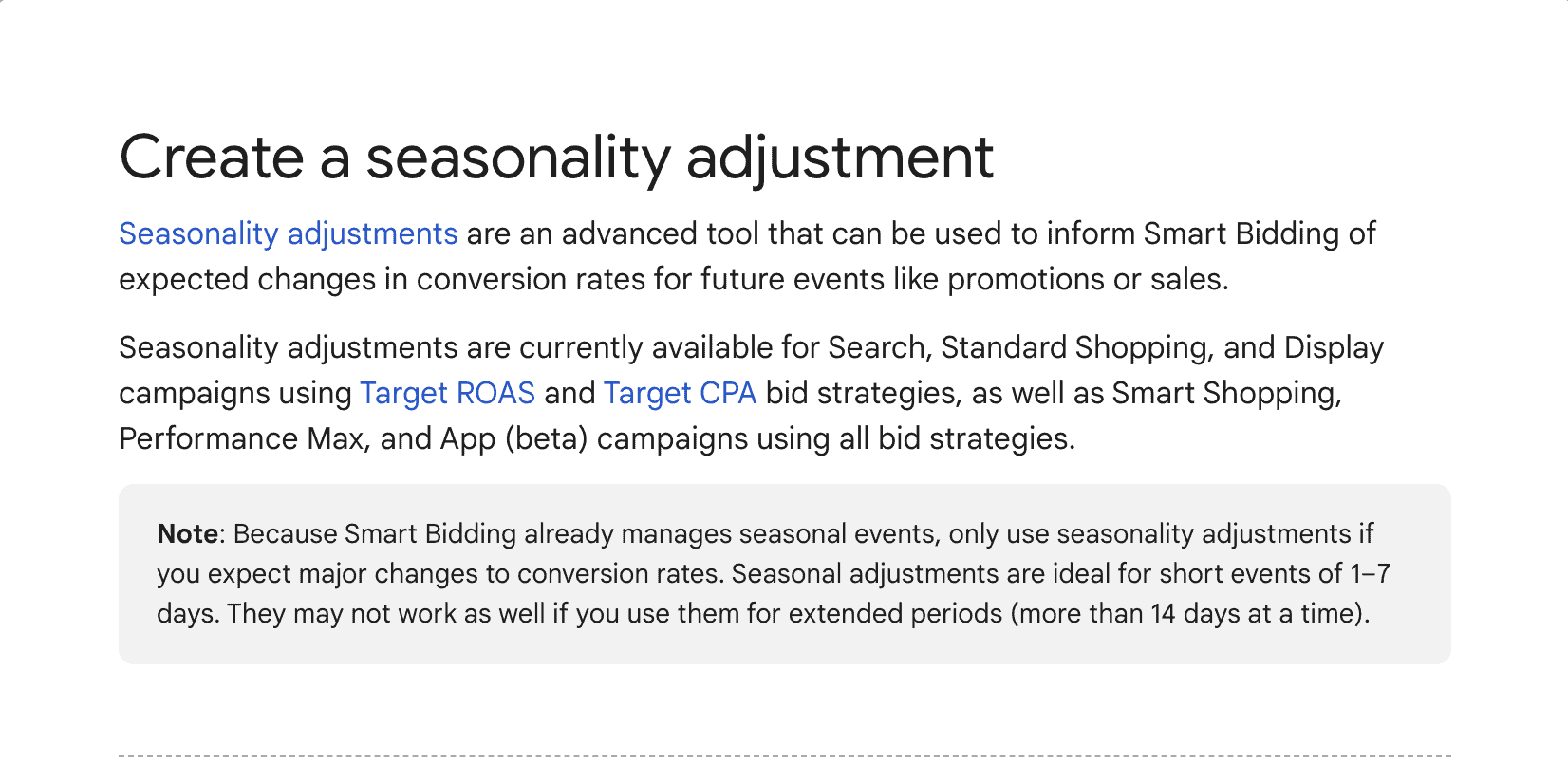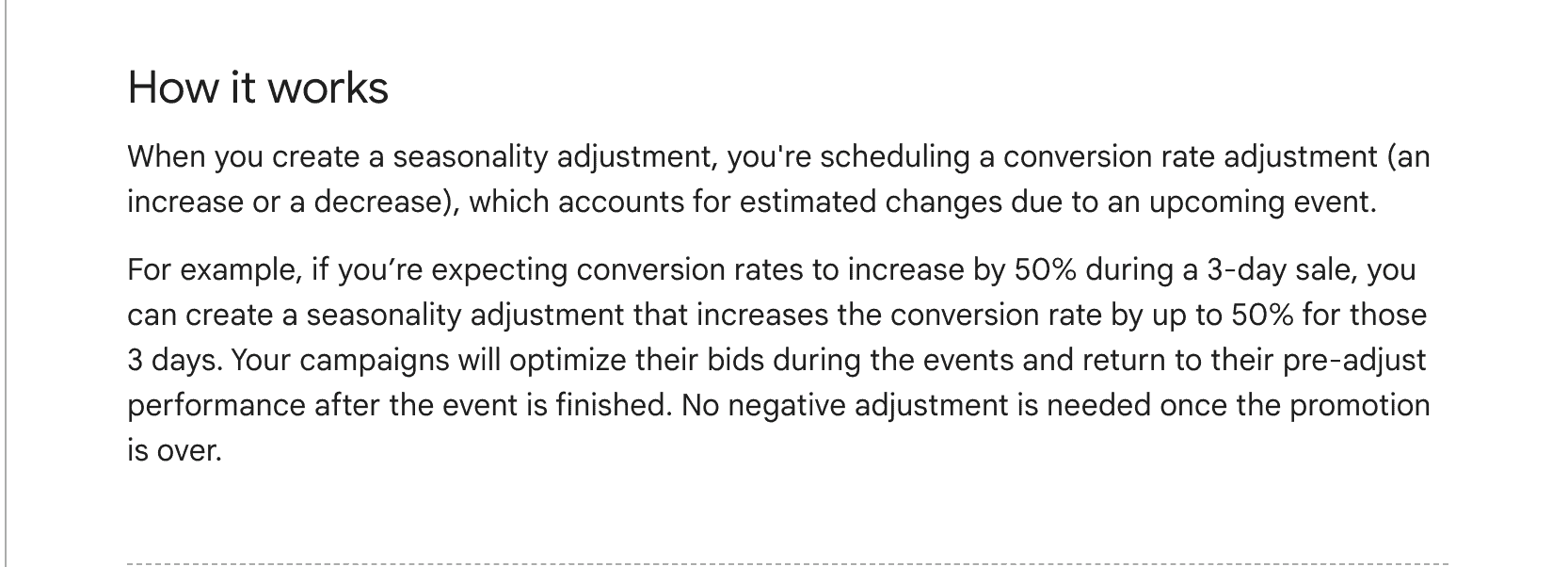Is your business seasonal? That is, subject to massive fluctuations around certain events (like Valentine’s Day — here’s looking at you, florists) or even promotions, like Black Friday or Cyber Monday. If so, you need to make sure your Google Ads campaign keeps up with your growth. The best way to do that? Seasonality adjustments!
The seasonality adjustments feature helps advertisers:
- Squeeze the maximum conversion volume during seasonal sales events where you expect to have much higher buyer intent
- Fine-tune campaign bidding strategies to respond to a sudden influx of consumer interest
- Increase the efficiency of Smart Bidding, by switching the focus from past performance to seasonal event dynamics
Thing is, though, you can set this up wrong. If you do, you’ll have wasted not only time, but also money

…And we don’t want that.
To save you from (a very preventable) seasonality adjustment disaster, we’re walking you through the entire set-up process — from using the correct settings, to maximizing your returns during major sales events like Black Friday and Cyber Monday — so you can maximize returns on your Google Ads campaigns when it matters most.
Let’s dive in.
Prefer video? What our YouTube video:
What are Seasonality Adjustments?
Google defines seasonality adjustments as a way to inform Smart Bidding of anticipated changes to your conversion rate during specific, future events.

We’re talking maximum 7-day long events. Do not use this for long periods of time.
When to Use Seasonality Adjustments?
At Grow My Ads, we only use seasonality bid adjustments for the biggest events — again, think Black Friday and Cyber Monday — where there’s an expected spike in conversions. Really, it’s whatever makes the most sense for you. If you’re an online flower shop, and you know your sales skyrocket around Valentine’s Day, you’ll probably benefit from adjusting your bid strategy during this time.
The bottom line? Seasonality bid adjustments can help you out massively any time you expect to see huge spikes in your conversions and conversion rate data, but use it sparingly.
How Seasonality Adjustments Work: (And Where Google Gets It Wrong)
Reverting back to Google for a minute (bear with us) — “When you create a seasonality adjustment, you’re scheduling a conversion rate adjustment (an increase or a decrease), which accounts for estimated changes due to an upcoming event. […] For example, if you’re expecting conversion rates to increase by 50% during a 3-day sale, you can create a seasonality adjustment that increases the conversion rate by up to 50% for those 3 days.”

The idea here is that during the event, your campaign will optimize bids by pinging Google’s algorithm to be more aggressive, then return to normal performance after the event is over
…But there’s a huge problem. The system isn’t very smart.
What does that look like? Well…
What we’ve seen is this: if you put in X% increase for the conversion rate, Google tends to also increase your average CPC (cost per click) by that percent.
So let’s say your average CPC is $1, and your conversion rate is going to increase by 100% for Black Friday.
If you plug that 100% expected increase into your seasonality bid adjustment for your Black Friday sales event, you’ll find that your average CPC goes from $1 to $2.
Now, there’s nothing wrong with taking a more aggressive bidding strategy during sales events, but you don’t want to blindly throw in a conversion rate number. That’s not smart. Here’s what you should do instead:
Analyzing Data for Informed Seasonality Adjustments
Let’s be smart. Your first step here is to analyze your data from past sales events. We’re talking your conversion rate, average CPC, and impression share. By digging into these metrics, you can calculate the percentage increase in conversion rate and make better, data-driven decisions about what your adjustment should be.
Setting Up Seasonality Adjustments:
The moment you’ve all been waiting for (well, the go-getters anyway — we see you)…a quick walkthrough on how to set up a seasonality adjustment. 
First, access the Seasonality Bid Adjustments feature in your Google Ads account:
- Navigate to Tools and Settings > Shared Library > Bid Strategies > Advanced Controls.
- Click New Seasonality Adjustment
- Choose the ‘conversion rate’ adjustment type.
- Name the event
- Set the specific date and time for the event (e.g., Black Friday).
- Under Scope, we recommend applying adjustments based on which campaigns performed well during the event last year. Also look at which products have increased more. If you have differences in conversion rates by product categories or campaign types, use them — we prefer this approach to a blanket, ‘total account’ approach.
- You can also filter by Devices.
A Better Way to Bid
Now, it’s time for The Big Thing — Conversion Rate Adjustment.

Google will tell you to “enter an estimate based on expected conversion rate changes.” Ignore Google. Listen to me instead. You want to avoid blindly entering estimated conversion rate increases. Rather, calculate the percentage increase based on your numbers from the same time last year. Here’s how it works:
- First, let’s revisit some of the account data from the same event last year. Check your conversion rate on the day of the event (or calculate the average during the event), then check your conversion rate on the day before the event.
- Once you have those two numbers, calculate the Percentage Increase. You can use an online calculator or, if you’re a math whiz, do it yourself using the formula:

Analyzing Data for Informed Adjustments
- Let’s say our numbers are 3.36% conversion rate on Black Friday, while we were around 2.2% before that. In our case, we’ve got a 52.7% increase in our conversion rate. This is NOT the number we want to put into our Estimated Conversion Rate. There are a few things we need to look at first — namely, Average CPC and Impression Share. This will help us strike a balance between aggressiveness and budget constraints.
- For example, let’s say you went from a $0.25 CPC to $0.31 CPC. You would then calculate the Percentage Increase, which is 24%. Then, review Impression Share by (Top) % — for our purposes, let’s say it’s pretty static.
- In this case, because we had a high impression share, we’re not going to adjust our conversion rate by 50% as we’d be spending more than last year unnecessarily. Instead, we’d lean more conservative, and say 30% because that’s what’s going to jump our average CPC.
- And just like that, you’ve set an airtight, data-driven seasonality adjustment — happy bidding!
Budget Considerations
Be mindful of how seasonality adjustments can impact your budget. The goal is to strike a balance between capturing the increased demand and maintaining cost-effectiveness.
These strategies should help you keep your CPC supportable, without sacrificing reach when it matters most.
Tweaking these settings may lead to increased or decreased spending during the event. When making your cost estimations, you’ll want to account for bid adjustments, expected increase in CTR, and changes in conversion rate.
Avoid Common Pitfalls
Successfully leveraging seasonality adjustments to get the most out of your campaigns means taking a strategic approach. By analyzing past performance metrics and avoiding common pitfalls, you can set the right conversion rate adjustments to maximize ROI during major sales events.
Don’t just rely on percentages, or blindly throw in a 100% impression share conversion rate increase — all that’s going to do is double up your bids. Plus, if you’re capped by budget, Google’s bidding algorithm might get way too aggressive way too early — blowing much of your spend by 11 a.m.

…And giving your competitors the rest of the day’s traffic. You’ve got to manage it.
Post-Event Analysis
After the event, analyze the effectiveness of your seasonality adjustments. Use this data to refine your strategy for future seasonal events.
Conclusion
In conclusion, delve into details of your data — don’t be afraid of a little granularity — and make sure you’re looking at the percentage increase from multiple different angles. Taken together, this will help you come up with a conversion increase percentage that makes sense based on your numbers, and unlock the power of seasonality adjustments!



